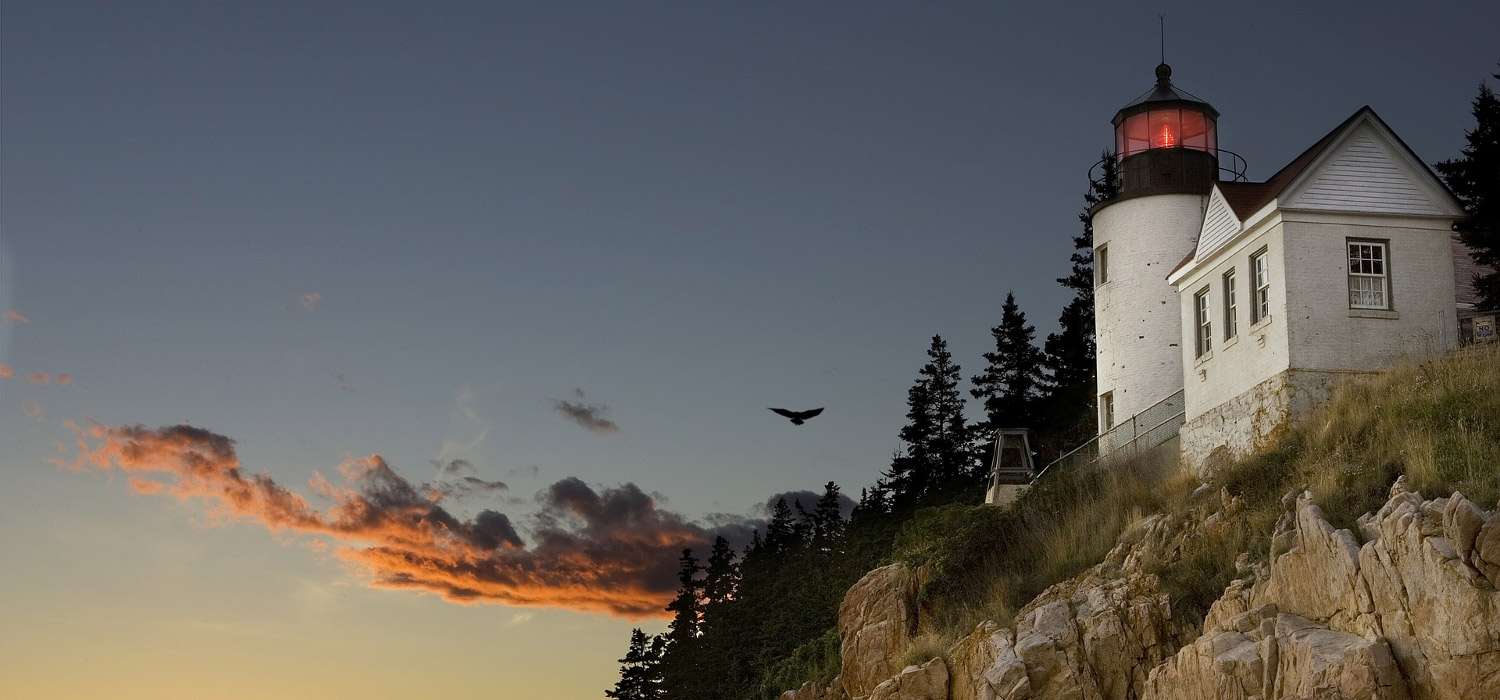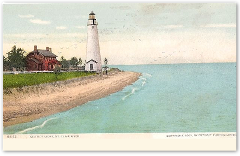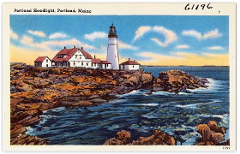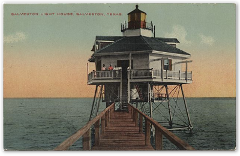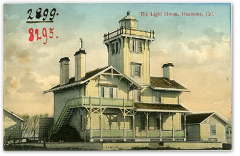Location: 42-19-40.855N x 070-53-24.266W; on Little Brewster Island, Boston Harbor
Station Established: 1716; original tower destroyed by British, 1776
Year Current/Last Tower(s) First Lit: 1783; tower raised in height in 1856
Operational: Yes
Automated: Yes, in 1998
Deactivated: n/a
Foundation Materials: Granite
Construction Materials: Rubble stone with a brick lining
Tower Shape: Conical
Tower Height: 89 feet
Lens Height Above Sea Level: 102 feet
Markings/Pattern: White with 5 steel bands and black trim
Relationship to Other Structure: Tower is separate
Stairway: 76 wrought iron steps
Original Lens & illuminant: Tallow candles (1716)
Current Lens: Second Order Fresnel lens (1859), 2 x 1,000-watt light bulbs; 1.8 million candlepower
Characteristics: Fl W 10s
Fog Signal: Yes
Historical Information:
The first lighthouse established in America was on Little Brewster Island in Boston Harbor and was first lit on September 14, 1716. A tonnage tax of 1 penny per ton on all vessels, except coasters, moving in or out of Boston Harbor, paid for maintaining the light. The first keeper, George Worthylake, with a salary of £50 a year, also acted as pilot for vessels entering the harbor. In 1718 he and his wife and daughter, with two men, were drowned when the lighthouse boat capsized as they were returning to the island from Boston. Young Benjamin Franklin, then a printer in Boston, wrote a ballad about the incident entitled "Lighthouse Tragedy" and sold it on the streets of Boston.
The pay of Keeper John Hayes was raised to £70 in 1718 so that he would not be obliged to entertain mariners on the island for extra money which he found "prejudicial to himself as well as to the town of Boston." In 1719 he asked "That a great Gun may be placed on Said Island to answer Ships in a Fogg" and one was supplied that year on which the date 1700 was engraved. The gun is shown on a mezzo-tint engraving of Boston Light made by Burgess in 1729. Hayes’ successor in 1734 was Robert Ball who petitioned the general court for preference in piloting vessels into the harbor. The court designated him as "established pilot" of the harbor for the next 3 years. In 1751 the lighthouse was badly damaged by fire so that only the walls remained.
In 1774 the British took over the island and in 1775 the harbor was blocked and the lighthouse became useless. On July 20, 1775, a small detachment of American troops under Major Voss visited the island and burned the wooden parts of the lighthouse. The British began to repair it under a marine guard, when General George Washington dispatched Major Tupper with 300 men in whale-boats on July 31, 1775, who defeated the guard and destroyed the repair work done. They were intercepted on leaving by British small boats and attacked. A direct hit on one of the English boats by an American field piece on Nantasket Head, caused the British to retire to their boats with comparatively heavy losses. Only one American was killed. Major Tupper and his men were commended by General Washington. When the British left Boston, March 17, 1776, a number of their ships remained in the harbor. On June 13, 1776, American soldiers landed on Long Island, Boston Harbor, and at Nantasket Hill and opened fire on this fleet who were soon at their mercy. Before sailing away, the British sent a boat ashore at Boston Light and left a time charge which blew up the lighthouse. The top of the old lighthouse was used to supply ladles for American cannon.
In 1783 the Massachusetts Legislature supplied £1,450 to erect a new lighthouse on the site of the old. This new lighthouse, which still stands, was 75 feet high with walls 7-1/2 feet thick at the base, tapering to 2 feet 6 inches at the top. The octagonal lantern was 15 feet high and 8 feet in diameter. Thomas Knox was appointed keeper. On June 10, 1790, the Boston Light was ceded to the new Federal Government. In 1811, Jonathan Bruce became keeper. He and his wife witnessed the thrilling encounter between the American frigate USS Chesapeake and the British frigate HMS Shannon on June 1, 1813, when Captain James Lawrence, USN, of the Chesapeake uttered the immortal words "Don’t give up the ship," as he was being lowered, mortally wounded, through the companionway. Nine minutes later, however, his crew was forced to surrender.
While Captain Tobias Cook of Cohasset was keeper in 1844 a "Spanish" cigar factory was set up on the island, with young girls brought from Boston to work in it, in an effort to deceive Boston smokers that the cigars manufactured there were imported. This business was soon broken up, however, as a fraud. In 1859, the height of the tower was raised to 89 feet and a second-order Fresnel lens was installed. The tower was reinforced with a brick lining and a brick entranceway was also installed. The optic remains in use to this day.
On November 2, 1861, the square rigger Maritana, 991 tons, which had sailed from Liverpool 38 days earlier, with Captain Williams, ran into heavy seas in Massachusetts Bay and approached Boston in a blinding snow, driven by a howling southeaster. At 1 o’clock in the morning of November 3, she sighted Boston Light and headed for it, but crashed on Shag Rocks soon after, with passengers and crew ordered into the weather chains after the crew had cut the masts away. The ship broke in two and Captain Williams was crushed to death, but seven persons floated to Shag Rocks atop the pilot house, while five others swam to the ledge, as fragments of the wreckage started coming ashore on both sides of Little Brewster Island. A dory from the pilot boat rescued the survivors from the rocks. When the Fanny Pike went ashore on Shag Rocks in 1882, Keeper Thomas Bates rowed out and took the crew safely off the ledge.
In 1893 the Massachusetts Institute of Technology sent 20 or 30 students to live on the island, while experiments were made with various types of foghorns in an endeavor to find one that would penetrate the area known as the "Ghost Walk" 6 or 7 miles to the east. On Christmas Day 1909 the five-masted schooner Davis Palmer, heavily loaded with coal, hit Finn’s ledge and went down with all hands. Nearly seven years later, on September 25, 1916, the Lighthouse Service commemorated the lighthouse's 200th anniversary. A pamphlet published by the Department of Commerce to mark the occasion noted: "The principal events of the day were the unveiling of a small commemorative bronze tablet at the Boston Light Station in the morning under the auspices of the Lighthouse Service; a meeting of the Bostonian Society in the afternoon at the old State House, Boston; and a dinner and evening meeting of the Boston Chamber of Commerce at the Old Beacon Club, Point Allerton, near Hull, from which point the assembled guests witnessed the first flashes of the light as it commenced its third century at sunset of the anniversary day."
When the Navy gunboat USS Alacrity (SP-206) stranded on the ice-covered ledges off the island on February 3, 1918, Keeper C. H. Jennings and his assistants made four attempts to shoot a rope to the trapped ship but each time the rope parted. Jennings brought the lighthouse dory to the shore, and, assisted by two naval reservists, pushed it over the ice and into the surf where they successfully rescued 24 crewmen. For this Jennings received a letter of commendation from Secretary of Commerce William C. Redfield: "for service rendered on February 3, 1918, in endeavoring to float the stranded U.S.S. Alacrity, under dangerous ice conditions, during bitterly cold weather, with a strong ebb tide. The department commends them for the promptness with which they answered the distress signal, and for the highly meritorious service rendered. The Secretary states: 'The skillful and intrepid manner in which you carried a dory across the island over icy and slippery rocks and lowered it with safety down the sides of high and jagged ice floes, while in danger of being crushed or capsized, carrying the crew of 24 men and the crew's dunnage to the rocks, and alter transferring crew and dunnage aboard when ship was about to be floated, commands the admiration of the department.'" Some later accounts have the Alacrity sinking but according to this report it was saved and refloated.
During World War II the light was extinguished as a security measure, but was again placed in operation July 2, 1945. The light was converted to electrical power in 1948 with power being supplied by a generator and back-up batteries. An underwater power cable was run to the station in 1957. In 1964 the lighthouse was designated as a Registered National Historic Landmark due to the efforts of Edward W. Small of the National Park Service. A plaque noting this distinction was attached to the tower. On September 14, 1966 the station celebrated its 250th anniversary with a ceremony held on the island that was hosted by RADM William W. Childress, Commander, First Coast Guard District. Noted lighthouse historian Edward Rowe Snow was the guest speaker at the commemorative ceremony. The lighthouse was listed on the National Register of historic Places in 1987.
The Lighthouse Service began automating lighthouses in 1923 and the Coast Guard continued that modification so that by 1989 plans were put in place to automate the Boston Light. Preservationists objected, however, and along with concerns about vandalism and the lighthouse's historic importance, Senator Edward Kennedy sponsored an amendment to the 1989 Coast Guard Reauthorization Bill to keep the station permanently manned. The amendment passed and Boston Light became the last, and only, operational station manned with paid keepers. The light light was automated on April 16, 1998 but keepers were still assigned to the station. In 2003, the Coast Guard hired a civilian keeper, Dr. Sally Snowman, who has been serving on site since 2003. She is the first female lighthouse keeper to serve at the Boston light.
The station is currently equipped with a 1,800,000 candlepower light refracted through the 1859 second order Fresnel lens. The light is visible for 27 miles.
Keepers:
- 1716-1718 George Worthylake Shadwell (Worthylake's slave)
- 1718 Robert Saunders
- 1718-1733 John Hayes
- 1733-1774 Robert Ball (longest serving keeper)
- 1774-1776 William Minns
- 1776-1783 Light out of service
- 1783-1811 Thomas Knox
- 1811-1833 Jonathan Bruce
- 1833-1844 David Tower
- 1844 Joshua Snow
- 1844-1849 Tobias Cook
- 1849-1851 William Long
- 1851-1853 Zebedee Small
- 1853-1856 Hugh Douglass
- 1856-1862 Moses Barrett
- 1862-1864 Charles E. Blair
- 1864-1893 Thomas Bates, Jr.
- 1893 Alfred Williams
- 1893-1894 Albert M. Horte
- 1894-1909 Henry L. Pingree
- 1909-1910 F. E. Tarr
- 1910-1911 Levi B. Clarke
- 1911 George Kezer
- 1911-1916 Mills Gunderson
- 1916-1919 Charles H. Jennings, J. A. Thurston (1st Assistant Keeper), J. L. Hart (2nd Assistant Keeper)
- 1919-1926 J. Lelan Hart
- 1926-1941 Lawrence Babcock (later BM1), Bickford Haskins (1st Assistant Keeper, 1934), Osborne Earle Hallett (2nd Assistant Keeper, 1937-1944)
- 1941-1945 Ralph C. Norwood
- 1945 BM1 Franklin A. Goodwin
- 1945-1946 Julio Di Furia
- 1946 Eldon W. Beal
- 1946-1948 Leo F. Gracie
- 1948 Stanley Batt
- 1948-1950 EN2 Joseph F. Lavigne
- 1950 BM1 John D. Hall
- 1950-1951 Robert C. Merchant
- 1951 EN1 Clinton M. Davis
- 1951-1952 EN1 Ray O. Beard, SN Richard B. Fredey (Assistant; SN Fredey died in the line of duty on 21 November 1952 along with contractor Wilfred MacNeill when they disappeared enroute back to Boston Light while aboard the station's 14-foot boat.)
- 1952 BM1 Robert A. Reedy
- 1952-1953 John Curran
- 1953-1954 Paul B. Guy
- 1954-1955 Hubert B. Jones
- 1955-1959 BM1 John E. Horner
- 1959-1960 BM3 James B. Collins
- 1960-1962 BM1 Gottfried Schiffers
- 1962-1967 BM1 William F. "Mike" Mikelonis, FN Donald M. Nashawath (Assistant)
- 1967-1969 BM1 Vernon T. Springer, David Vitale (Assistant; Oct 1967-1969)
- 1969-1971 BM1 Alick Rust
- 1971-1972 BM1 Dennis I. Reed
- 1972-1973 BM1 Edward J. O'Shea
- 1973-1974 BM1 James H. Clark, Jr.
- 1974-1975 BM1 James H. Turner
- 1975-1977 BM2 Alan D. Achorn
- 1977-1978 BM1 Carlon F. Brietzke
- 1978-1980 BM1 Marvin D. Gonzalaus
- 1980-1982 BM1 Hal Murra, MK2 Pete Perron, Tony Kuliak & Roger Emmons (Assistants)
- 1982-1984 BM1 James F. Burt
- 1984-1985 BM1 Paul V. Dodds, Patrick Doherty (Assistant)
- 1985-1987 BM1 Guy a. Veillette
- 1987 BM1 Joe B. Lanard
- 1987-1988 BM1 K. J. Galvin
- 1988-1990 BM1 Dennis Dever
- 1990-1992 BM1 Alexander "Sandy" Booth, James McClurkin & SN Scott Gamble (Assistants)
- 1992-1995 BM1 Wesley T. Pannett
- 1995-1997 BM1 Reid Hair
- 1997-1999 BM1 Scott Stanton
- 1999-2001 BM1 Richard Himelrick
- 2001- BM1 Pedro Gonzales
- 2003- Sally R. Snowman
Content provided by www.uscg.mil

